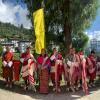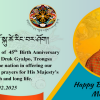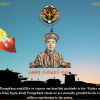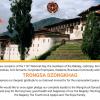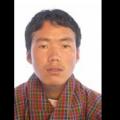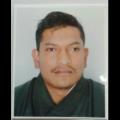livestock
VISION:
Sustainable natural resources for equitable social and economic well being of the Bhutanese people and the nation.
MISSION:
To ensure sustainable social and economic well-being of the Bhutanese people through adequate access to food and natural resources.
LIVESTOCK SECTOR OBJECTIVES AND TARGETS
- To attain self sufficiency in livestock products and increase nutritive value in the daily diet
- Support for livestock production, processing, packaging and access to market
- To enhance rural income from sale of surplus livestock products
Sector Strategies
- With technical and financial support from projects and RGoB, will establish semi-commercial and commercial dairy, piggery and poultry farms in the gewogs
- To sensitize on livestock technology for adoption by farmers through promotional program towards rural poverty intervention
- Supply of more livestock inputs – piglets, pullets, breeding stock, AI inputs, pasture seeds, fodder slips and fodder tree seedlings at a subsidized rate
- Support for processing, packaging and marketing of products
- To upgrade skills & knowledge of extension staff and farmers by providing regular training/study tour in various livestock related fields and also provide adequate office equipments, infrastructure and other necessities.
- To produce quality feed & fodder and to make availability of adequate feed resources to all livestock through improvement of feed and fodder production programme for betterment of livestock production.
- Form more farmers group to promote common wealth and interest to ensure balanced economic development in the community
- Organize demonstration/trials/field days/exhibition
- Support in infrastructure development
- Catering of animal health services to prevent and reduce outbreak of notifiable & other important livestock diseases through regular vaccination, clinical treatments and prophylaxis
- Reduction of unproductive cattle
Livestock Sector Staff Strength: 11
- 5 extension staff in five RNR-Extension Centers
- 3 Dzongkhag Veterinary Hospital
- 3 in Dzongkhag Head Quarter.
Services Provided to Farmers:
- Clinical treatment of animals on case by case basis
- Vaccination of animals against wide range of diseases such as Foot and mouth disease, Black quarter, Anthrax, Rabies, Hemorrhagic septicemia, Swine fever, Newcastle disease, etc
- Artificial insemination to improve the quality of the cattle breeds
- Feed and fodder development
- Establishment of backyard, commercial and semi-commercial farms with technical support from the RGoB.
- Control of external and internal parasites of all livestock categories
The extension staffs also provide support services to the clients in famers training, conducting study tours, demonstrations, and livestock exhibitions to learn how to rear and manage better breeds of livestock with higher production with improvised management system.
As per Livestock Census 2017, livestock population in the Dzongkhag is 20,931 numbers, of which 70% bringing to a total number of 11583 are cattle and 30 % composite of horse, poultry, pig, sheep, goat, dog and cat. The Dzongkhag has predominant number of local cattle because the farmers can easily rear under adverse climatic condition with scarce fodder, whereas the improved breeds like Jersey and Brownswiss require high quality feed with better management system. Although the Livestock Sector emphasizes in cross breeding of local cattle with improved breeds for better production but there are still significant number of local cattle population throughout the Dzongkhag. The awareness campaigns to educate the famers will have immense benefit to solve the problem.
Service Center
| RNR center without AI | 1 | |
|
4 | |
| Veterinary Hospital with AI | 1 | |
| AI Centre | 2 | |
| Staff | 12 | |
| Caretakers | 6 |
Livestock Population data 2016-2020
| Livestock Population | 2016 | 2017 | 2018 | 2019 | 2020 |
|---|---|---|---|---|---|
| Local Cattle | 6865 | 7616 | 7172 | 4126 | 4919 |
| Improved Cattle | 3542 | 3968 | 3893 | 7100 | 3787 |
| Yak | 284 | 226 | 305 | 303 | 259 |
| Pig | 10 | 38 | 1 | 4 | 23 |
| Poultry | 11737 | 6000 | 7153 | 12955 | 9296 |
| Horse | 189 | 216 | 211 | 162 | 96 |
| Sheep | 107 | 132 | 124 | 140 | 162 |
| Goat | 62 | 92 | 103 | 98 | 24 |
| Dog | 426 | 544 | 599 | 636 | 639 |
| Cat | 752 | 874 | 1053 | 1058 | 932 |
Livestock Production data 2016-2020
| Livestock Production | 2016 | 2017 | 2018 | 2019 | 2020 |
|---|---|---|---|---|---|
| Milk(MT) | 1404.98 | 1434.26 | 1520.31 | 1627.49 | 1546.86 |
| Butter(Kg) | 52461 | 65418 | 70.44 | 73.98 | 67.31 |
| Cheese(Nos) | 295323 | 311417 | 121.86 | 126.61 | 111.3 |
| Egg(mill) | 0.75 | 1.13 | 1118.26 | 1086.3 | 1234.52 |
| Beef(Kg) | 56699 | 67490 | 27.24 | 35.03 | 32.79 |
| Pork(MT) | 0.35 | 4.90 | 3 | 0.96 | 0.81 |
| Chugo(Kg) | 2008 | 540 | 4.5 | 2.45 | 0.23 |
| Wool(Kg) | 50 | 49 | 14.43 | 0.12 | |
| Chicken(Kg) | 3048 | 4729 | 3.14 | 14.58 | 2.12 |
Private farms (Backyard & Semi-commercial)
| Dairy | Poultry | Pig | Fish | Pasture dev |
|---|---|---|---|---|
| 471 | 35 | 1 | 0 | 1067 acres |
Milk processing unit
| Gewog | Nos |
|---|---|
| Tangsibjee | 1 (Functional) |
| Drakteng | 1 (Functional) |
| Nubi(milk booth) | 1 (Functional) |
| Langthel(milk booth) | 1 (Functional) |
